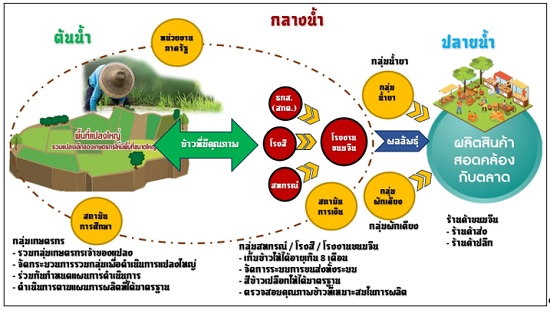CAPACITY DEVELOPMENT OF BUSINESS GROUPS THROUGH CLUSTERING : A CASE STUDY OF KHANOM CHIN PRODUCTION GROUPS IN NAKHON PATHOM PROVINCE
DOI:
https://doi.org/10.14456/nrru-rdi.2021.33Keywords:
Khanom chin production, Capacity development, Business clusterAbstract
The two objectives of this basic research were: 1) to study the model of the Khanom chin business cluster in Nakhon Pathom Province, and 2) to study the important components and the guidelines for capacity development related to driving the Khanom chin business cluster in Nakhon Pathom Province. This study was based on a qualitative research methodology through observations and in-depth interviews. There were 45 key informants, consisting of 3 groups, including 30 people from a farmers group, 6 people from a processing and marketing group and 9 people from a support group. The research tool was examined by 3 experts, jointly editing the interview form to meet the objectives of the research. Data were analyzed by 3 steps of the qualitative research analysis process, including data organization, data display and triangulation. The study results revealed that there were 4 groups in the Khanom chin business cluster: 1) “Nakhon Pathom Model”, 2) “AMC Model” (Agricultural Marketing Co-operative Limited), 3) “Khao Yoi Model” and 4) Bua Lom Chang Model” (Ban Hin Mun Sub-Districts). There were 5 important components for capacity development: 1) external support, 2) leadership and management, 3) the process within the cluster, 4) production development, and 5) product development meeting the marketing demand. The capacity development may be achieved in 3 ways: 1) development of production plans and infrastructure, 2) government support, and 3) product development meeting the marketing demand.
References
Anek, T., Mr. (2019, 17 December). Khanom Jeen Factory operator. Interview.
Ceriyìng, D., Mr. (2019, 10 December). Rice Department Officer. Interview.
Chai-amporn, S. (2012). The social capital implementation ability of Ban Bang Phrai Community, Bangkhonthi District, Samut Songkram Province. Journal of the Association of Researchers 17(1), 29-41. (In Thai)
Chai-amporn, S. (2013). Qualitative research for development: concepts, methods and applications. Bangkok : National Institute of Development Administration. (In Thai)
Chamnanpon, K., Boonkoum, W., & Sungrugsa, N. (2016). A Development Model of Tourism Market Network Management in the Small and Micro Community Enterprise in Thailand to Prepare for ASEAN Economic Community. Ratchaphruek Journal, 14(3), 80-86. (In Thai)
Chanpaso P., & Suwaenadchariya, C. (2016). Procedures and Ways to Specify Tourism Clusters in Songkhla Province. FEU Academic Review, 10(2), 97–113. (In Thai)
Chok, T., Mr. (2019, 25 December). Rice mill operator. Interview.
Division of Research Administration and Educational Quality Assurance. (2016). Blueprint of Thailand 4.0 Model Drive Thailand to Prosperity, Stability and Sustainability. Retrieved December 25, 2019 from https://waa.inter.nstda.or.th/stks/pub/2017/20171114-draeqa-blueprint.pdf (In Thai)
Institute for Small and Medium Enterprise Development. (2018). Institute of Small and Medium Enterprise Development. Retrieved November 12, 2018, from http://www.ismed.or.th (In Thai)
Kasetkaoklai. (2017). Nakhon Pathom Model. Retrieved December 17, 2019 from https://www. kasetkaoklai.com (In Thai)
Khodphue, S. (2008). Factors affecting implementation of community enterprises in San Pa Tong District, Chiang Mai Province. Thesis, Master of Science (Agriculture) Program in Agricultural Extension, Chiang Mai University, Chiang Mai. (In Thai)
Kraidet, L. (2003). Kanom Jeen: Thai food-local wisdom and Thai economy and industry. Folk wisdom Thai Development: Commemorative Arts and Culture Promotion Fair, 5th, 24-26 January 2003 (pp. 84-86). Walailak University, Nakhon Si Thammarat. (In Thai)
Kriwanit, P. (2004). The Cluster development process: a case study of Northern Handicraft Manufacturer and Exporters Association. Chiang Mai: Graduate School, Chiang Mai University. (In Thai)
Lengwiriyakul, K., & Jarernsiripornkul, S. (2017). Development Approach on Tourism Cluster of Chai Khong Road, Chiang Khan District, Loei Province. MBA-KKU Journal, 10(1), 220-246. (In Thai)
Maturos, L. (2012). Transformational Leadership, Effectiveness of Sustainable Cluster Development and Commitment of Silk Product Cluster Members in Ubon Ratchathani Province. Journal of Management Science, Ubon Ratchathani University, 1(1), 63-81. (In Thai)
Phinaitrup, B. (2012). Capacity Development of SMEs throght Cluster-based Approach: Vegetable and Beef Clusers. NIDA Development Journal 52, (3), 155-192. (In Thai)
Phochathan, S. (2016). Capability Development of SMEs through Cluster-based Approach: Healthy Food Industrial Cluster in Nakhon Ratchasima Province. Ratchaphruek Journal 14(2), 46-52. (In Thai)
Pitaksarn, S. (2013). Factors affecting the successful implementation of the community enterprise promotion policy: A case study of Mueang Krabi District, Krabi Province. Academic Services Journal, 24(3), 33-46. (In Thai)
Porter, E. M. (1998). Clusters and the New Economics of Competition. Harvard Business Review 76(6), 77-90.
Pothisai, A. (2009). New price insurance policy for Thai farmers. Retrieved December 20, 2019 from https://www.senate.go.th/assets/portals/93/fileups/272/files/S%E0%B9%88ub_Jun /11all/all16.pdf (In Thai)
Rice Department. (2016). Report on the situation of rice cultivation. Retrieved December 8, 2017 from http://www.ricethailand.go.th/web/ (In Thai)
Secretariat Office of Community Enterprise Promotion Board (2008). Community Enterprise. Retrieved November 12, 2017 from http://www.sceb.doae.go.th/Ssceb2.htm
Suranartyuth, A. (2010). A study of the factors contributing to the success of industrial cluster implementation in Thailand, Thesis, Doctor of Philosophy Program in Development Administration, National Institute of Development Administration, Bankok. (In Thai)
Suttiprapa, T. (2012). Cluster and sustainable competitiveness enhancement: A case study of Chanthaburi Gem and Jewelry Industry Cluster. Bangkok : College of Innovation, Thammasat University. (In Thai)
Thai Rice Exporters Association. (2017). Rice export statistics. Retrieved December 17, 2019 from http://www.thairiceexporters.or.th/default_th.htm (In Thai)
Wattanapunkitti, P. (2016). Factors Contributing to Success of Community Enterprises of 5 Star OTOP in Lampang Province. Kasalongkham Research Journal, 10(2), 17-26. (In Thai)





